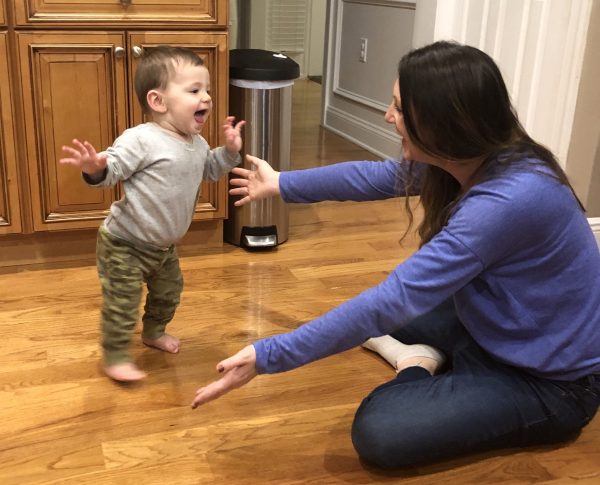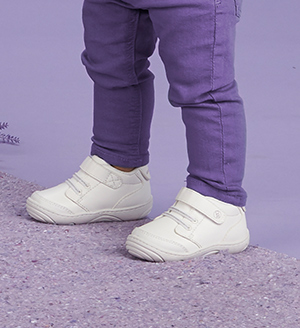14 Tips to Get Your Baby or Toddler Walking
1. BE SURE THEY HAVE MET ALL PREVIOUS MILESTONES
Make sure that your child is at a developmentally appropriate age and level for them to walk. Don’t push them to do it too early or before they’re ready.
Your child should already be able to crawl, stand while holding on, stand independently, and cruise (walk while holding on) before you expect them to walk independently. Of course, crawling doesn’t have that much to do with walking, as some children do walk instead of crawling. However, crawling is a very important milestone that I recommend every child do before walking.
If they have hit all of those stages, then you can start teaching your baby to walk. If not, start working on standing and cruising before taking independent steps.
2. GO BAREFOOT

No socks. No shoes. Just bare feet. There are tiny muscles in the feet that need to start developing and strengthening and the only way to do this is by bearing weight on them.
As bipeds (animals that walk on two feet), we have so many little muscles that help us to balance and give traction as we stand. When you stand barefoot, the muscles in your feet have an easier time ‘grasping’ the ground. This will help those little muscles work harder to find the perfect way to mold to the ground in order to help your baby walk.
Not only does going barefoot help with walking, but it’s a great sensory experience for your child, too. All the nerve endings in the bottom of their feet will get to feel different surfaces and textures. These sensory signals get sent up to the brain and provide more awareness to the feet. This can even help with walking, as well.
Barefoot means no socks, as well. Socks will just cause them to slip and don’t provide enough traction for new walkers.
3. STURDY SHOES
Get rid of those baby crib shoes with soft soles. Those aren’t going to work anymore.
Your baby needs a shoe with good support at the ankle and the sole. Remember, your baby has not yet used the muscles of their ankle and lower legs too much yet so you may need to provide external support to get those muscles working.
Although barefoot is the best, when you’re out and about, your child will need shoes. Also, since every child is different, your baby may not do well with bare feet and may stand better with sturdy shoes.
They can keep their ankles from rolling or wobbling or just to make them feel sturdier.
Stride Rite is one of the best shoe brands for your little ones that provide great support for an early walker, both on the sole and ankle. *You can get them at a discounted price on Amazon.*
4. BABY STEPS
Start small and don’t expect that your child will jet across the living room when they first learn to walk. They will slowly begin to take 1 or 2 steps at a time. While you are teaching them, remain very close. If they can only take 2 steps right now, don’t sit 3 feet away from them. Gradually increase the distance as they get more confident.
5. ENCOURAGEMENT AND MOTIVATION

Be sure to celebrate every attempt and that will encourage your child to do more! We all need a little motivation in order to do things so celebrate every little victory, whether it is two steps or even just an attempt to take a step.
The biggest motivation for a child is a parent’s smiling face. Make sure you’re actively engaging with your child and should start to see their abilities strengthen.
6. REDUCE THEIR FEAR
Keep objects and furniture close so they know that they always have something sturdy to hold on to. Again, make sure you’re always standing close enough to them with your arms open wide ready to catch them if they fall. Once they realize that they won’t get hurt if they fall, their fear should be reduced and they may be more confident to take a few more steps
7. GRADUALLY REDUCE SUPPORT
You can hold your baby under their arms, on their trunk, or on their hands. As they learn and gain muscle strength, they will need less and less support. Make sure you are decreasing the amount of support and assistance that you give them as they learn to walk.
8. PROVIDE GOOD ROLE MODELS
What’s more encouraging to a child than seeing another child do it? Watching another child their age try out walking will often give your baby the push they need to get started. They may like to see them fall and get up again or see that the other child got a lot of praise for walking.
This is where a daycare or childcare facility is helpful, however if you have other siblings, cousins, or friends, make sure to have plenty of playdates for them to engage with others.
9. STRENGTHEN THEIR MUSCLES
As I mentioned before, your child needs to develop and strengthen their leg and trunk muscles in order to start walking. Make sure that you’re giving them exposure to do so.
The best way for your baby to develop the muscles of their legs is by standing. If your child can’t hold themselves up yet, you can support them under their arms. As long as they are bearing weight into their feet with their legs straight,they are working out those muscles.
10. PRACTICE AND CONSISTENCY
This is always my biggest tip for learning any new skill. Practice makes perfect!! Don’t think that by attempting to walk with your child once a day, they will begin walking on their own. Set aside several periods of time throughout the day to practice with them.
Whether it be in the morning when they first wake up, after lunch, or right before bath time, aim to work on your goal several times. Be consistent with these tips and activities. The more your child gets familiar with your expectations of them and what activity is coming up, the more confident and excited they will feel.
11. ALWAYS PLACE THEM DOWN ON THEIR FEET
After holding your child, place them down in a standing position instead of sitting. You may be used to putting them down in sitting and that may be easiest for them, but you want to take every opportunity to get them bearing weight into their feet. Even if they plop down as soon as you place them down, you’re still letting them know that your expectation is for them to stand up.
12. ALLOW THEM TO CRUISE ON FURNITURE

Your baby will first learn to walk while holding onto furniture. Make sure all the pieces are sturdy as they will be pushing most of their weight onto it. Give them access to long lines of furniture (couches and coffee tables) to provide them with opportunities to cruise along it.
13. START WITH A FIRM SURFACE
Although it can be scary to allow your wobbly, unbalanced infant to walk on hardwood floors or tile, this is the best place for them to learn.
Once they’re a little steadier on their feet, use those soft or uneven surfaces to challenge their balance a bit more. Once they get the hang of standing and walking a bit, using a variety of textured grounds like carpet, beds and couches (while supervised), and grass are great for the sensory experience, as well as improving their balance.
14. TWO ADULTS ARE BETTER THAN ONE
When having a child learn to take a few steps, it’s best to have two adults instead of just one. This merely provides the encouragement and motivation that your child may need to get started. This way one adult can encourage the child, as the other one gives him support at the other end.


